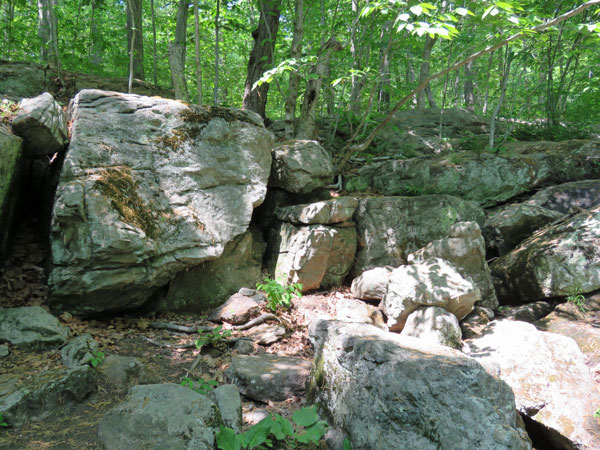
remains of 18th century grist mill dam
We first came to this open space property three years ago, at the beginning of the pandemic, and have been here many times since. Since we know we’re going to North Carolina in a few months this visit seemed special because we were well aware that we may never pass this way again.

A few days ago I spent some time sorting through my “walks” index file, pulling our favorite walks out of the rotation so we might visit them one last time before we go. Please forgive me for this very lengthy post. I want to save as many picture memories as possible!

Usually we walk down to the waterfall and back up the hill, but this time we explored two side trails. First we walked upstream to the dam and walked out on it until the break which lets the brook through now. Then we hopped down off the dam and walked along the brook, getting a different view. With no leaves on the trees yet we could see a lot of the features in the woods.

the break to restore the water flow is visible between the two dam sections
the dam is above the waterfall, behind me

By the time it came to the edge of the Forest, the stream had grown up, so that it was almost a river, and, being grown-up, it did not run and jump and sparkle along as it used to do when it was younger, but moved more slowly. For it knew now where it was going, and it said to itself, “There is no hurry. We shall get there some day.” But all the little streams higher up in the Forest went this way and that, quickly, eagerly, having so much to find out before it was too late.
~ A. A. Milne
(The House at Pooh Corner)

We had never been at the top of the waterfall before. Tim even went out over it a little bit. My legs didn’t seem long enough to jump down where he was.


Then we found the main trail again and made our way down to below the waterfall. I was looking forward to getting pictures of an old tree with amazing roots extending into the brook.





After crossing the footbridge and getting the above pictures we decided to follow a new trail for a little bit. Sheep Farm South, a property adjoining this one, was purchased by the Groton Open Space Association in April 2021. New trails were created on it and linked to the existing ones on Sheep Farm. So we started down this one which passes by a large moss covered outcrop. It was taller than Tim.






After we passed the outcrop we found a path that went up above it and walked through the woods a bit until we circled around and spotted the waterfall below us. I’m pretty sure the little vine below is partridge berry. It looks like the plant my brother-in-law identified for us at Connecticut College Arboretum, although not as lush looking.





Before crossing the footbridge I noticed a side view of the tree with the water hugging roots. It was a rough trip back up the long hill to the parking lot because Tim’s sciatica started acting up, but he made it. Perhaps we strayed a little too far this time but we did get to see a lot of things we haven’t seen before.


Packing boxes have arrived and I’m feeling overwhelmed with the enormity of the task before us but it was great spending a little time outside in the woods we will miss so much.























































































